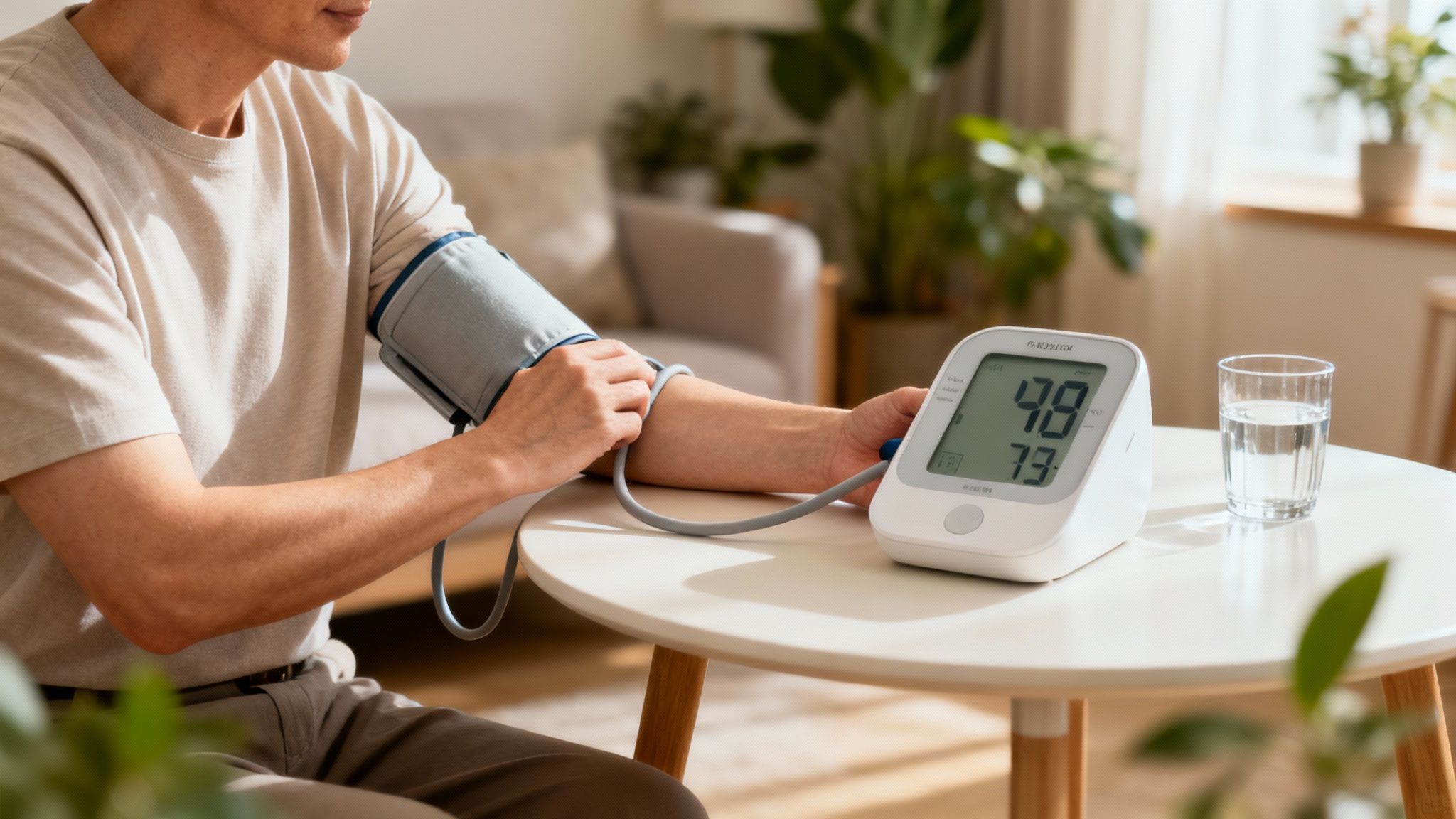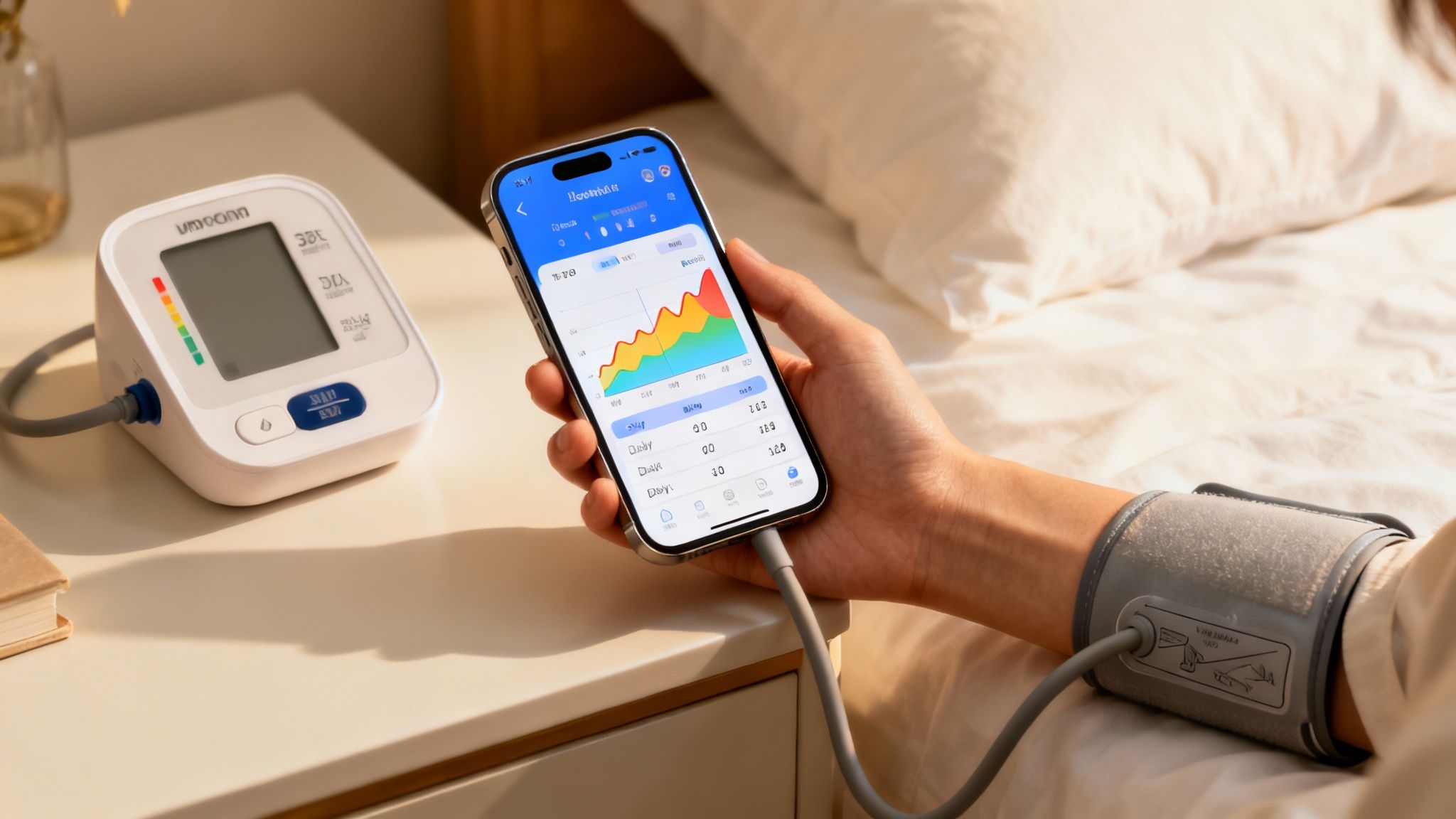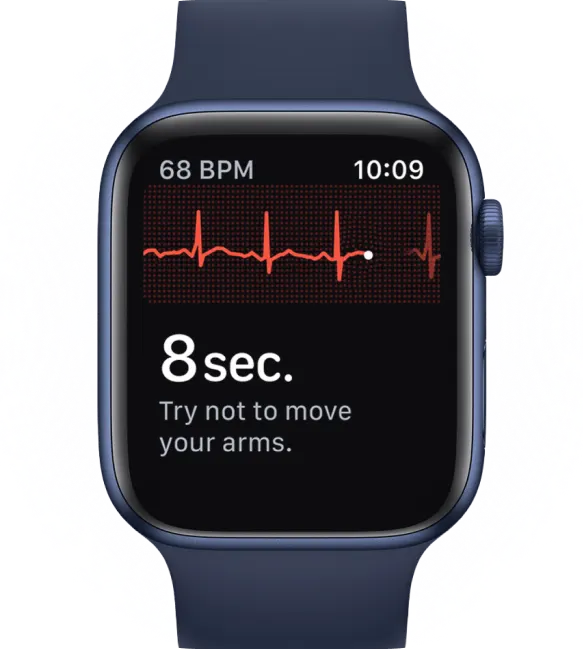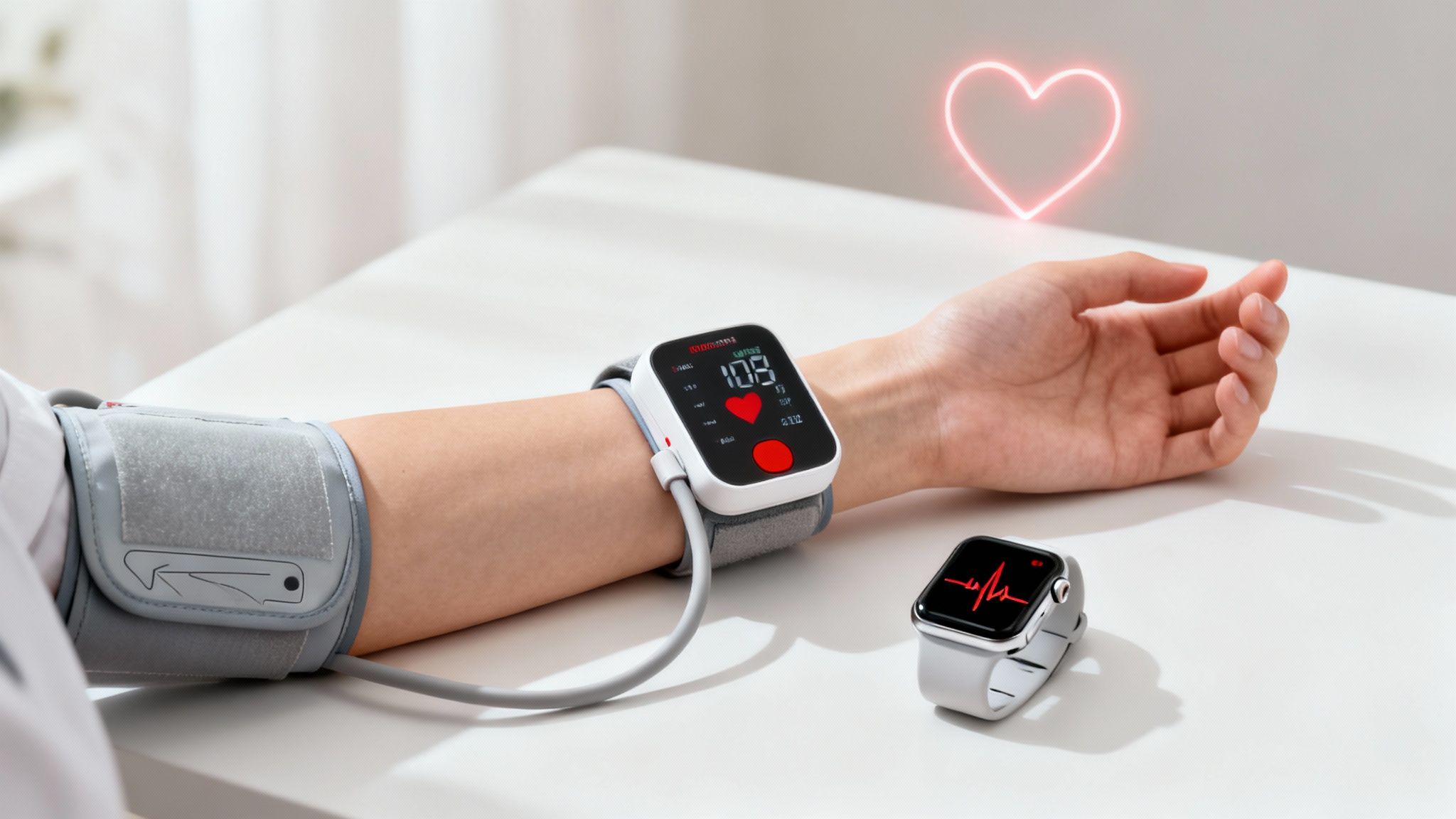Key Takeaways
Hello, Heart Hero. We get it. Hearing words like “blood pressure” can feel a little intimidating, and maybe you're a bit skeptical about the traditional healthcare routine and are looking for ways to take more control yourself. It’s completely normal to feel that way.
Think of this as your starting point for learning about your body without any judgment or confusing medical jargon. Our only goal is to help you build confidence right from the beginning. By the end, you won't just know your numbers; you'll understand what they actually mean for you. This knowledge is what puts you in the driver's seat.
The Garden Hose Analogy
Let's break this down with a simple analogy. Imagine your arteries are a garden hose and your blood is the water. Your heart is the faucet controlling the flow.
- When you turn the faucet on full blast (your heart contracts), the pressure inside the hose shoots up. This powerful push sends water surging through.
- When you turn the faucet down (your heart rests between beats), the pressure drops, but there's still a steady flow of water moving through the hose.
This simple comparison helps make sense of the two numbers you see in a blood pressure reading, taking the mystery out of the whole process.
Decoding the Two Numbers
When you get your blood pressure checked, you'll always see two numbers, something like 120/80 mmHg. Let's stick with our analogy to see what each one means.
Systolic Pressure (the top number): This measures the pressure in your arteries when your heart beats. It's that moment of peak pressure, just like when the garden hose faucet is cranked wide open. This number tells you how hard your heart is working to pump blood out to your body.
Diastolic Pressure (the bottom number): This measures the pressure in your arteries when your heart is resting between beats. Think of it as the "background" pressure in your system, like the steady but lower pressure in the hose when the faucet is turned partway down.
Both numbers are equally important. They work together to give you a complete picture of your cardiovascular health and serve as the starting point for any conversation about your well-being.
Why Your Blood Pressure Numbers Matter
It's one thing to know your blood pressure numbers, but it's another thing entirely to understand why they matter. It might just seem like two numbers from a cuff, but they tell a powerful story about what's happening inside your body. Let's walk through that story together, focusing on building knowledge, not anxiety.
Think of your blood pressure as your body's private, 24/7 delivery service. It’s the force that pushes life-giving, oxygen-rich blood through your arteries to every single cell, from your brain all the way to your toes. When your blood pressure is in a healthy range, that delivery system runs smoothly and efficiently, keeping all your organs nourished and happy.
The Two Sides of the Story: Systolic and Diastolic
Like we touched on earlier, your blood pressure reading comes in two parts. Each one gives us a crucial clue about your heart's rhythm.
- Systolic (Top Number): This is the peak pressure when your heart contracts and pumps blood out. It’s the moment of maximum force on your artery walls during a heartbeat.
- Diastolic (Bottom Number): This is the pressure in your arteries when your heart is resting between beats. Think of it as the baseline pressure that's always present in your circulatory system.
Both numbers are critical. Together, they give us a snapshot of your cardiovascular health at that moment.
What is a Normal Blood Pressure Range?
For most adults, the sweet spot for blood pressure is a reading of less than 120/80 mmHg. This range suggests your heart and arteries aren't being overworked to get blood where it needs to go. Your internal delivery system is humming along without any unnecessary wear and tear.
But remember, these numbers are just a guide. What’s “normal” can differ a bit from person to person. The real key isn’t to chase one perfect number but to get a sense of your personal trend over time.
When your blood pressure is consistently high, your heart has to pump much harder. Over time, this constant extra effort can strain not only your heart muscle but also the delicate lining of your arteries, setting the stage for potential health issues down the road.
This is exactly why paying attention to your numbers is so important. The goal isn't perfection, but awareness. Consistently high blood pressure, or hypertension, is often called a "silent" condition because it rarely shows obvious symptoms at first. But inside your body, the impact can be significant.
Prolonged high blood pressure can damage the inner walls of your arteries, making them tougher, less elastic, and more prone to plaque buildup. As the arteries narrow, it becomes even harder for blood to flow freely. This is not something that happens overnight; it's a gradual process. And that’s precisely why small, proactive steps can make such a huge difference. By understanding the "why" behind the numbers, you can truly appreciate how every healthy choice is a direct investment in keeping your body's vital delivery system running smoothly for years to come.
Your Journey to Understanding Blood Pressure
If a new blood pressure diagnosis has you feeling a bit lost, or you're just trying to make sense of your numbers, please know this: you are absolutely not alone. Taking this first step to understand your health is a huge win, and it’s a journey shared by millions of people just like you all over the world.
Sometimes, dealing with a personal health concern can feel isolating. You might wonder if you're the only one trying to figure all this out. The truth is, high blood pressure (hypertension) is one of the most common health conditions on the planet.
A Shared Global Conversation
Looking at blood pressure from a bigger perspective can be surprisingly reassuring. It removes the stigma and helps us see that this isn't some personal failing, but a widespread health issue that many people are managing successfully.
This global view highlights the enormous community of individuals, families, and healthcare professionals all working toward the same goal: better heart health. That means more research, better support systems, and more shared knowledge for everyone.
The Staggering Numbers
The number of people with hypertension worldwide is massive. An estimated 1.4 billion people are living with high blood pressure. And even though it’s both preventable and treatable, uncontrolled high blood pressure is a leading cause of major health events. You can see more of these global stats from the World Health Organization and their efforts to improve healthcare worldwide.
This isn't meant to scare you, but to empower you. It shows just how much your proactive steps matter and reinforces why managing blood pressure is a critical focus for health organizations everywhere. It’s a recognized challenge with a vast network of support behind it.
One of the most important takeaways from global health data is that only about one in five people with hypertension have it under control. This highlights a significant opportunity for individuals to take charge of their health through monitoring and lifestyle adjustments.
This gap shows just how vital your personal engagement is. Small, consistent efforts can place you in that empowered group that successfully manages their health.
Why This Matters for You
Understanding the global picture helps put your own journey into perspective. You're part of a massive, collective effort. The challenges are widely recognized, and the goal of proactive health management is a shared one.
It also underscores the deep connection between blood pressure and other parts of your heart health. For instance, managing hypertension is a key factor in preventing heart rhythm problems. You can learn more about this link in our detailed guide on how hypertension can cause AFib.
Seeing the bigger picture helps reinforce that every healthy choice you make is a step toward joining a worldwide community committed to living healthier, more vibrant lives. You are part of a massive, positive movement.
How to Measure Your Blood Pressure at Home

Taking your own blood pressure might seem like a clinical task, but it’s one of the most empowering things you can do for your health. Let's be real: a doctor's office can be stressful. Many people see their numbers spike the moment they sit on that crinkly paper, a common phenomenon known as “white coat syndrome.”
Measuring at home, where you’re comfortable and relaxed, gives you a much truer picture of your day-to-day blood pressure. This isn't about replacing your doctor; it's about becoming an informed partner in your own care. You're gathering real-world data to help you and your healthcare provider make the best decisions together.
Let's walk through the process, step-by-step, so you can feel confident you're getting accurate readings every time.
Choosing Your Home Blood Pressure Monitor
First things first, you need the right tool for the job. You'll see a lot of options out there, but your best bet is an automatic, upper-arm cuff monitor. Why the upper arm? Because wrist and finger monitors are known to be less reliable.
Look for a monitor that has been clinically validated for accuracy. A quick search for validated device lists from health organizations can go a long way. But the single most crucial factor? Cuff fit.
A cuff that’s too small will squeeze too tight and give you a falsely high reading. One that’s too large will be too loose and give you a falsely low number. Measure the circumference of your upper arm and pick a cuff that’s sized correctly.
Preparing for an Accurate Reading
Getting a trustworthy reading is about more than just strapping on the cuff and hitting "start." What you do beforehand matters just as much. Think of it as setting the stage for an accurate performance.
For about 30 minutes before you take a measurement, try to avoid anything that can temporarily raise your blood pressure:
- Caffeine: That means coffee, tea, and some sodas are off-limits for a bit.
- Exercise: Don’t measure right after a workout or any strenuous activity.
- Smoking: Nicotine causes a temporary spike, so hold off.
Next, find a quiet spot where you can sit and just be for at least five minutes. This short rest period allows your body to settle into its baseline state, giving you a reading that reflects your true resting blood pressure.
The Right Way to Take Your Measurement
Okay, you're calm, prepped, and ready. Nailing the measurement itself comes down to a few simple but important details.
- Sit Correctly: Find a chair with good back support. Sit up straight, keep your feet flat on the floor, and uncross your legs.
- Position Your Arm: Rest your arm on a table or armrest. The key is to make sure the cuff is level with your heart. Let your palm face upward.
- Place the Cuff: Slide the cuff onto your bare upper arm (not over clothing). The bottom edge should be about an inch above the bend of your elbow. It should be snug, but not strangling. You should be able to slip two fingers underneath it.
- Stay Still and Quiet: Once you press the start button, no talking or moving. Just relax and breathe normally.
- Take Two Readings: To be sure, take two or three readings, about one minute apart. This helps confirm the number is consistent. Log the results in a notebook or a health app.
Following these steps ensures you're getting a reliable snapshot of your blood pressure. For those wanting an even more complete view, learning how to check heart health at home can add another valuable layer to understanding your overall well-being.
Lifestyle Choices for Healthy Blood Pressure
This is where your journey truly becomes your own. When we talk about managing blood pressure, it’s easy to get bogged down in prescriptions and doctor’s visits. While medical guidance is absolutely essential, the power you hold is in what you do every single day between those appointments. This is where you take the driver's seat.
The small choices we make daily add up to have a huge impact on our heart health. We’re not talking about impossible diets or workouts that leave you feeling defeated. Instead, we're going to explore gentle, sustainable habits that actually fit into your real life. Think of it as making small, positive shifts that create a big difference in how you feel, putting you firmly in control.
Move Your Body in Ways You Enjoy
When you hear the word “exercise,” your mind might jump straight to running marathons or spending hours in a loud gym. Let's reframe that right now. The real goal is simply to get your body moving in ways that feel good to you, helping your heart become stronger and more efficient over time.
Regular physical activity is like strength training for your heart muscle. A stronger heart can pump more blood with less effort. This, in turn, reduces the force on your arteries and helps lower your blood pressure. Learning how to build cardiovascular endurance is a fantastic starting point for anyone looking to improve their heart health with actionable steps.
Here are a few gentle ways to get started:
- A daily walk: Just 30 minutes of brisk walking on most days can make a world of difference. You can even break it up into three quick 10-minute walks if that's easier.
- Gardening or yard work: These activities are a great mix of light cardio, movement, and fresh air.
- Dancing: Seriously, just put on your favorite music and move around your living room. It's a joyful way to get your heart rate up without feeling like a chore.
- Stretching or yoga: These practices improve flexibility and are amazing for reducing stress, which has a direct, positive effect on your blood pressure.
Nourish Your Body with Heart-Friendly Foods
The food you eat is one of the most direct and powerful tools you have for supporting healthy blood pressure. This isn’t about banning your favorite treats. It’s about consciously adding more of the good stuff. Focus on simple swaps that are both delicious and beneficial.
Certain foods are packed with nutrients like potassium, magnesium, and fiber, all known to help keep blood pressure in check. Think of it as giving your body the best possible building blocks for a strong, healthy cardiovascular system.
Making small, consistent changes to your eating habits can lead to significant improvements. It’s all about progress, not perfection. A diet rich in whole foods naturally helps lower your intake of sodium and unhealthy fats, two key players in blood pressure management.
Some simple, powerful additions to your plate include:
- Colorful Vegetables and Fruits: Aim to fill half your plate with a rainbow of veggies and fruits. Things like leafy greens, berries, and bananas are fantastic sources of potassium.
- Wholegrains: Swapping white bread for wholegrain, or white rice for brown rice, adds valuable fiber that your heart loves.
- Lean Proteins and Healthy Fats: Bring in more fish, nuts, seeds, and legumes. Unsalted nuts and seeds, in particular, are little powerhouses of healthy fats and minerals.
- Low-Fat Dairy: Plain yogurt or milk can be great additions, providing key nutrients as part of a balanced eating plan.
The Overlooked Power of Rest and Relaxation
Life is stressful; there's no getting around it. But chronic stress can keep your body in a constant "fight or flight" mode, which can contribute to high blood pressure over time. Finding healthy ways to manage that stress isn't a luxury; it’s an absolute necessity for your heart.
This looks different for everyone. For some, it might be quiet time spent in nature. For others, it could be a creative hobby like painting or just listening to calming music. The key is to find what helps you unwind and make it a non-negotiable part of your routine.
Equally important is sleep. Good quality sleep is when your body does its most important repair work. During deep sleep, your blood pressure naturally drops. Consistently getting 7-8 hours of restful sleep per night gives your entire cardiovascular system a much-needed break, helping to regulate your blood pressure during the day.
Using Technology to Support Your Heart Health

It’s easy to feel a bit disconnected from your own health journey in the long stretches between doctor’s appointments. But modern tools are changing that. Think of them less as complex gadgets and more as supportive partners, keeping you tuned in to your own well-being.
The point isn't to replace your doctor's advice. Not at all. It's about giving you the power to see what’s really happening day-to-day, far from the "white coat" stress of a clinic. These tools can act as a personal health diary that organizes itself, offering up clear insights that actually make sense.
Making Sense of Your Data
One of the best tools you can own is an automated home blood pressure monitor. As we’ve talked about, getting accurate readings at home is the key to seeing the real, everyday patterns of your blood pressure. This consistent data is pure gold.
When you start tracking these numbers over time, trends emerge. Does your blood pressure spike after a stressful workday? What does it look like after a week of healthy eating and daily walks? Seeing these connections for yourself is incredibly powerful. It turns abstract advice into tangible results you can see right on the screen.
Technology gives you a voice in your own healthcare. When you can show your doctor a clear record of your blood pressure trends, it transforms your conversation from a brief checkup into a collaborative planning session based on real-world evidence.
This information helps you and your provider make smarter, more personalized decisions together. It's about building a true partnership for your health.
Wearables and Apps as Your Personal Guide
Beyond dedicated monitors, many of us are now using smartwatches and health apps to keep an eye on our hearts. These devices can track everything from activity levels and sleep patterns to your heart rate. Some even offer ECG capabilities to check your heart rhythm.
This lets you see the bigger picture of your cardiovascular health. You might notice, for example, how a few nights of poor sleep correlate with higher blood pressure readings the next day. This kind of holistic view is crucial for understanding how interconnected your daily habits are with your long-term heart health.
If you use a smartwatch, diving into our guide on the health features of the Apple Watch can show you how to get the most out of your device.
Here’s how these tools can support you:
- See Clear Trends: Instead of guessing, you get visual charts of your progress over weeks or months.
- Stay Motivated: Tracking your efforts and seeing positive changes is a huge motivator to stick with healthy habits.
- Feel in Control: Understanding your body's patterns helps reduce anxiety and puts you back in the driver's seat of your well-being.
Ultimately, the goal is to use this technology to listen to your body more closely. It’s a way to tune in to your health, understand your unique patterns, and feel more confident on your journey.
Your Blood Pressure Questions Answered
It's completely natural to have questions as you start paying closer attention to your health. Curiosity is a great sign that you're taking an active role in your own well-being, and we've gathered some of the most common questions to give you clear, straightforward answers.
If you're feeling a bit overwhelmed, you're not alone. Nearly 119.9 million adults in the United States are managing high blood pressure. But here's the kicker: only about 22.5% of them actually have it under control, according to these facts on high blood pressure from the CDC. These numbers show just how important this conversation is.
Can Blood Pressure Change Throughout the Day?
Yes, it's supposed to! Your blood pressure is constantly adapting to what you're doing, your stress levels, and even the time of day. It's usually at its lowest while you're sleeping and naturally starts to rise as you wake up.
This is exactly why monitoring your blood pressure at home is so powerful. A single reading at the doctor's office is just one snapshot in time. Tracking it at home gives you the full story, revealing patterns that are unique to you.
Is One Number More Important Than the Other?
Both numbers, systolic (the top number) and diastolic (the bottom number), are crucial for a complete picture of your heart health. For a long time, doctors focused mainly on the systolic number, but we now know that both provide critical insights.
Think of them as two key pieces of a puzzle. An elevated reading in either one can signal a potential issue, and looking at them together gives you a much clearer view of what's happening inside your arteries.
Your health journey is a marathon, not a sprint. Every question you ask and every small step you take is a victory. The goal is progress and understanding, not instant perfection.
What If My Doctor Recommends Medication?
If your doctor brings up medication, it’s a very common and effective way to manage high blood pressure. Lifestyle changes are the foundation of good heart health, but sometimes they aren't quite enough to bring your numbers down to a safe range.
Medication is a tool that works with your healthy habits, not against them, to protect your heart from long-term damage. It's important to have an open conversation about any questions or concerns you might have. To help you prepare, check out our guide on common blood pressure medications and their side effects.
At Qaly, we believe understanding your heart shouldn't be confusing. Our expert-led ECG analysis service helps you make sense of your wearable device data, providing clarity and peace of mind within minutes. Take control of your heart health journey by trying Qaly today at https://www.qaly.co.
Heart feels off? Get your ECGs read by certified experts within minutes, for peace of mind ❤️










.png)
.png)